+962 7 9635 8199
[email protected]
One of the best-preserved desert buildings of the Umayyads, the Unesco World Heritage Site of Qusayr Amra is the highlight of a trip into the Eastern Desert. Part of a much greater complex that served as a caravanserai, bathhouse and hunting lodge, the qusayr (little castle) is renowned for its rather risqué 8th-century frescoes of wine, women and wild times.
Qasr Amra Located beside Wadi Al-Butum, on the north side of Jordan’s Highway 40, roughly 85 kilometres from Amman and 21 kilometres southwest of Al-Azraq.
It is currently within a large area fenced off in barbed wire. An unpaved parking lot is located at the southeast corner, just off the road. A small visitor’s center collects admission fees. The castle is located in the west of the enclosed area, below a small rise.
Location: Zarqa Governorate, Jordan
Coordinates”: 31.801935°N 36.57663°ECoordinates: 31.801935°N 36.57663°E
Elevation: 520m
Built: 743 A.D.
UNESCO World Heritage Site
It was built some time between 723 and 743, by Walid Ibn Yazid, the future Umayyad caliph Walid II, whose dominance of the region was rising at the time. It is considered one of the most important examples of early Islamic art and architecture.
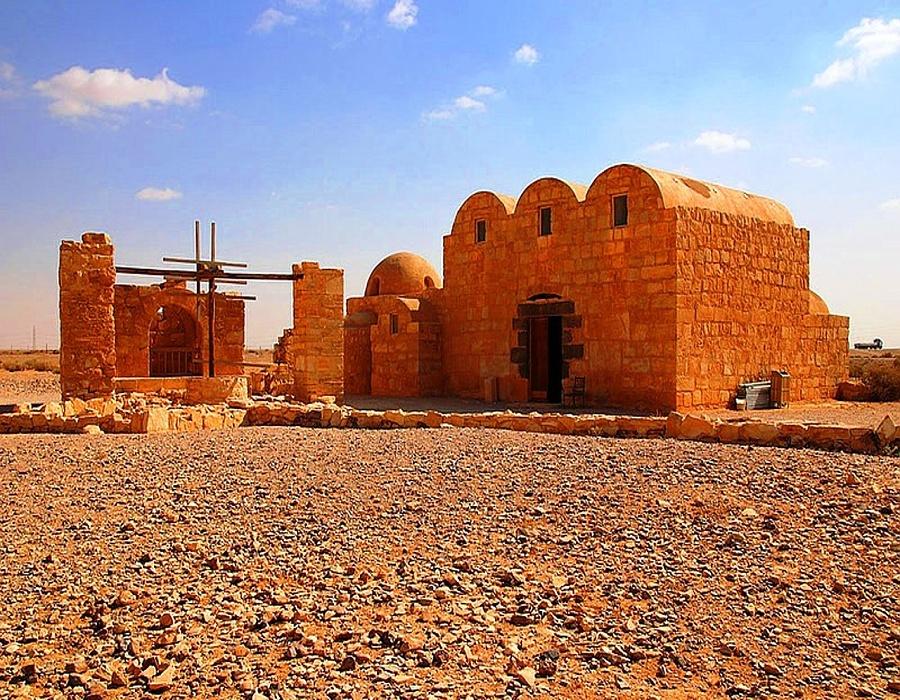
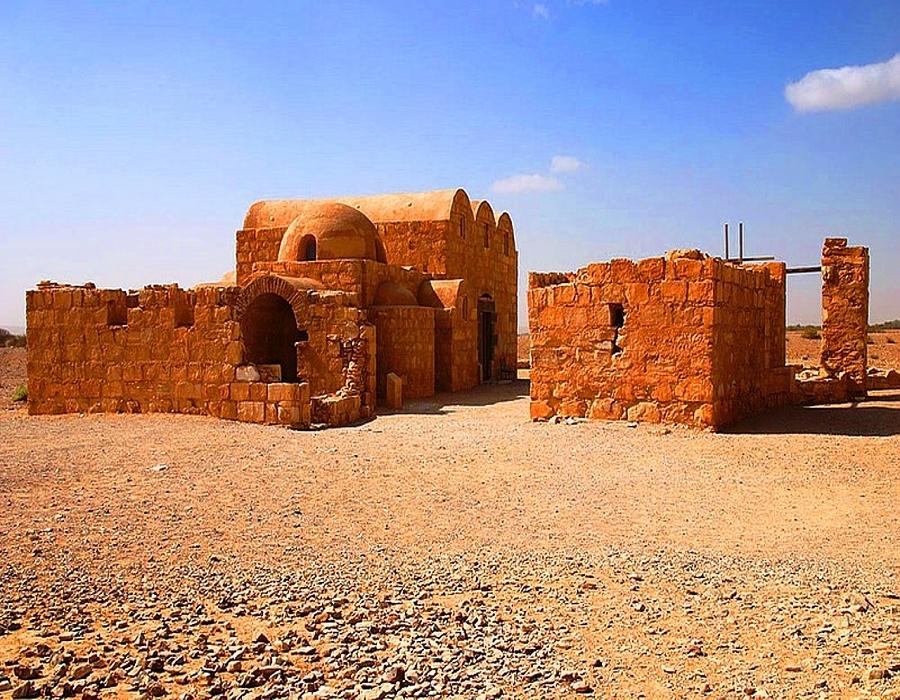
The building is actually the remnant of a larger complex that included an actual castle, meant as a royal retreat, without any military function, of which only the foundation remains. What stands today is a small country cabin. It is most notable for the frescoes that remain mainly on the ceilings inside, which depict, among others, a group of rulers, hunting scenes, dancing scenes containing naked women, working craftsmen, the recently discovered “cycle of Jonah”, and, above one bath chamber, the first known representation of heaven on a hemispherical surface, where the mirror-image of the constellations is accompanied by the figures of the zodiac. This has led to the designation of Qusayr ‘Amra as a UNESCO World Heritage Site. The bathhouse is also, along with examples in the other desert castles of Jordan, one of the oldest surviving remains of a hammam in the historic Muslim world.
That status, and its location along Jordan’s major east–west highway, relatively close to Amman, have made it a frequent tourist destination.
Qusayr ‘Amra is composed of a mixture of archaeological ruins over an area of around 2 km2. It consists of three principal structures:
i. A rectangular audience hall with a throne alcove in the middle of the south side
ii. A bath (Hammam) complex which comprises three rooms corresponding to the frigidarium (cold), tepidarium (warm) and calidarium (hot)
iii. The hydraulic structure, which includes:
An elevated water tank
A masonry lined deep well
The apparatus for drawing water from the well into water tank.

The entrance leads into the main audience hall with a water basin in its northeast corner.
The hall is parted in three longitudinal aisles of the same width : aisle IA (western), IB (central) and IC (eastern), each covered by barrel vaults underpinned by two large, slightly pointed arches.
To the south, the hall continues into the so-called “throne room” which gives access, on the east and on the west, to two separate alcoves.
These apsidal rooms are also covered by barrel vaults and are windowless. Their floors are covered by geometric mosaics in relatively good state of preservation.
To the east of the main audience hall a smaller door leads to the steam bath. The area is divided in three rooms of approximately 6 m2 each: the changing room or apodyterium; the warm room or tepidarium; and the hot room or caldarium.
The apodyterium is characterized by a stone bench running along its southern and eastern walls and it is covered by a barrel vault. The tepidarium and caldarium are respectively covered by a cross-vaulted roof and by a dome resting on pendentives. They were warmed by the hot air coming from the nearby furnace and circulating in the hypocaust and through terracotta pipes placed under the walls’ marble covers, now lost. Hot and warm water pools were also available in these two rooms.
The main hall is characterized by paintings covering all walls in their entirety, from the ground floor to the ceiling and vaults. The lower part of the paintings, from mid of the walls to the floor, displays architectural motifs, alternating false marbles and lesenes topped by Corinthian capitals with palmettes. The upper part and vaults host a variety of scenes from private, court, and public life.
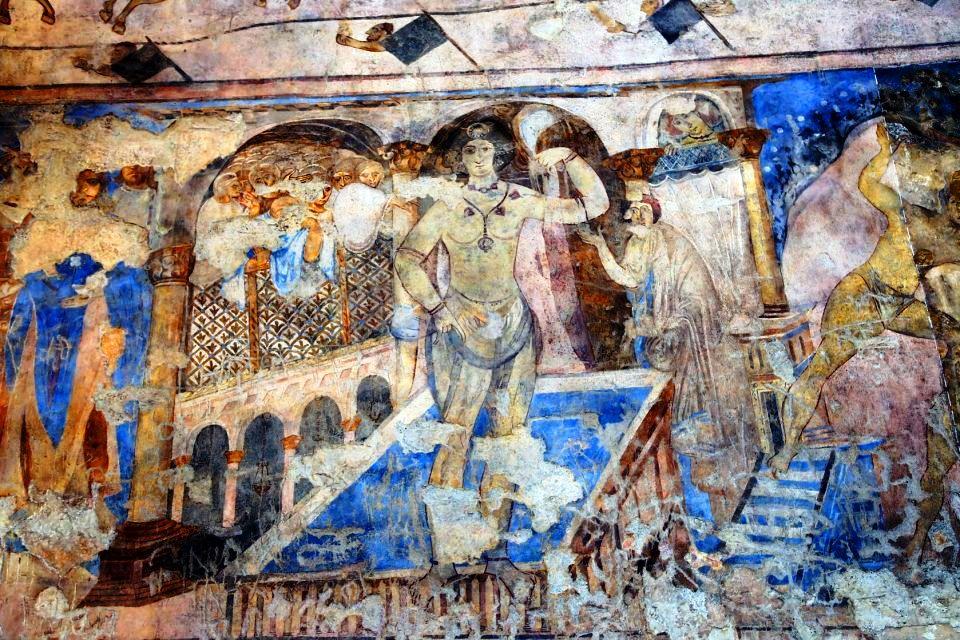

In aisle IA (western) the upper part of the western wall displays a hunting scene with men capturing a herd of onagers by pushing them into an area surrounded by a net. Below, a composite scene juxtaposes wrestlers (to the right), a bathing woman (in the centre), and a procession of six kings (to the left). Inscriptions above the heads of the kings qualify them as the Byzantine Caesar, King Roderic of Spain, the Sasanian emperor Chosroes and the king of Abissinia.
Two more kings cannot be recognized as their inscriptions are lost. The opposite wall is seriously damaged and few figures appear in the back, including standing people, a basket of grapes and an animal.
The northern wall of this aisle is also very damaged, but a marine scene can be recognized.
The southern wall is particularly preserved and displays a person sitting under a tent and wearing rich garments.
The person, a man, is surrounded by other figures, including a scribe, two children, and a woman weaving a fan. The scene is completed by the image of two peacocks under two Greek inscriptions: APA (Ara) or XAPIS (Charis) and NIKH (Nike). While the former word is still in discussion (in Ancient Greek, Charis would mean “grace”), the latter, Nike, clearly means “victory”. Below the man is a Kufic inscription within a tabula ansata, with letters of greyish colour on a blue background.
The inscription was recently investigated on the occasion of the new discoveries linked to the ongoing conservation project. On three lines, the inscription clearly begins with a basmala formula (bismiLlâh al-rahmân […]) Above the richly dressed man a different scene is displayed. Two sitting figures appear on the two sides of the building’s southwestern window. They are seemingly thinking, and recent interpretations suggest they may represent the two prophets Jonah and Job, based on fragmentary Greek letters found above their heads.
In the aisle IB (central) the lower part of the paintings, at the level of the arches, displays a series of richly dressed women and men within natural and architectural settings. The upper part starts just above the arches and extends to the whole vault. The decorative space is divided in 32 squared spaces framing human figures engaged in a variety of leisure and other activities such as music, love and sports.
The perimetral walls of the building are made with stone blocks and a rubble core. The structure is similar to others of the same period, such as Hammam as-Sarrah, in the vicinity of Qasr Hallabat. In the lower part, ashlars are alternated with small flat horizontal stones as to make setting beds regular. Similar walls were also found in Qasr al-Kharraneh and in the Amman Citadel’s mosque. The internal part of the wall is made of rubble of the same stone, randomly bedded in a gray and friable mortar mixed with ash. The masonry is about 75 cm thick, ensuring appropriate strength. Neither the great, slightly-pointed arches separating the two aisles in the main hall, nor the central aisle in the same hall have any buttresses.
The aisle IC (eastern ) is mainly characterized by scenes of onagers’ hunt and killing, variously displayed on its eastern, southern and western walls. The vault is the most remarkable element of this aisle, and provides a comprehensive catalog of different types of construction works.
Divided in small, squared and framed fields, the vault depicts activities which presumably contributed to the construction of the monument. They are represented in four lines of eight squares each, and each line represents a different series of activities: blacksmiths while they are forging metal; carpenters shaping wood; masons while squaring stone blocks; laborers while preparing mortar and so forth. Each of these activities are represented in temporal sequence, from obtaining the raw material to producing the final results.

To the south, the main hall continues into the so-called throne room. The key image is depicted on its southern wall and displays a person sitting on a throne and sided by two characters. Above this representation there is a poorly conserved inscription which mentions a “crown prince of the Muslim men and women” (walî ( ahd al-muslimîn walmuslimât). The eastern and western walls are also decorated with a sequence of men and women wearing rich garments and surrounded by Corinthian columns supporting semi-circular arches within a natural setting. On the two sides of the throne room there are two small doors that allow access in the two alcove rooms.
These rooms are richly decorated with phytomorphic patterns representing curly vine tendrils, pending grapes and rich, geometric mosaics on the floors. The lower part of the walls is decorated with architectural motifs and fake marble slabs.


Paintings also cover the bath area, particularly the upper part of the walls and the vaults. In the apodyterium, the barrel vaulted ceiling is decorated with a net of rhomboids created by sequences of phytomorphic patterns, probably palmettes.
The rhomboids frame various human and animal figures, including a musician bear, gazelles, herons and dancers.
In the center of the vault there is a series of three human busts (a boy, a young man and an old man) which have been interpreted as the representation of the cycle of life.
The two lunettes in this room are also decorated with figurative scenes: a man with a winged Eros, mourning over what has been interpreted as a body wrapped in a shroud; and two people, a woman and a man, seemingly looking at each other through the eastern window of the apodyterium.
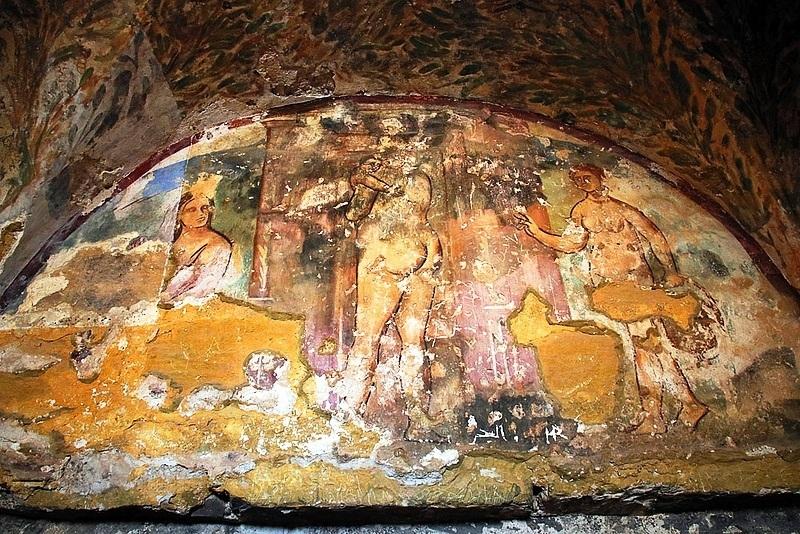
In the tepidarium the crossvaulted ceiling is decorated with phytomorphic patterns of intertwined leaves. These patterns extend to its northern lunette, above the window, where they are enriched by curly vine tendrils and pending grapes framing images of animals (a lion, a hare) and of a man collecting grapes.
The other three lunettes display figurative scenes with a nude woman holding a little child. A woman enters from the right with a bucket in her left hand.
On the left, there is a seated woman with long hair falling over her right shoulder. women and babies, possibly at the bath and within an architectural setting.
The dome ceiling of the caldarium displays a representation of the zodiac, which is thought to be the oldest extant spherical representation of the northern sky.
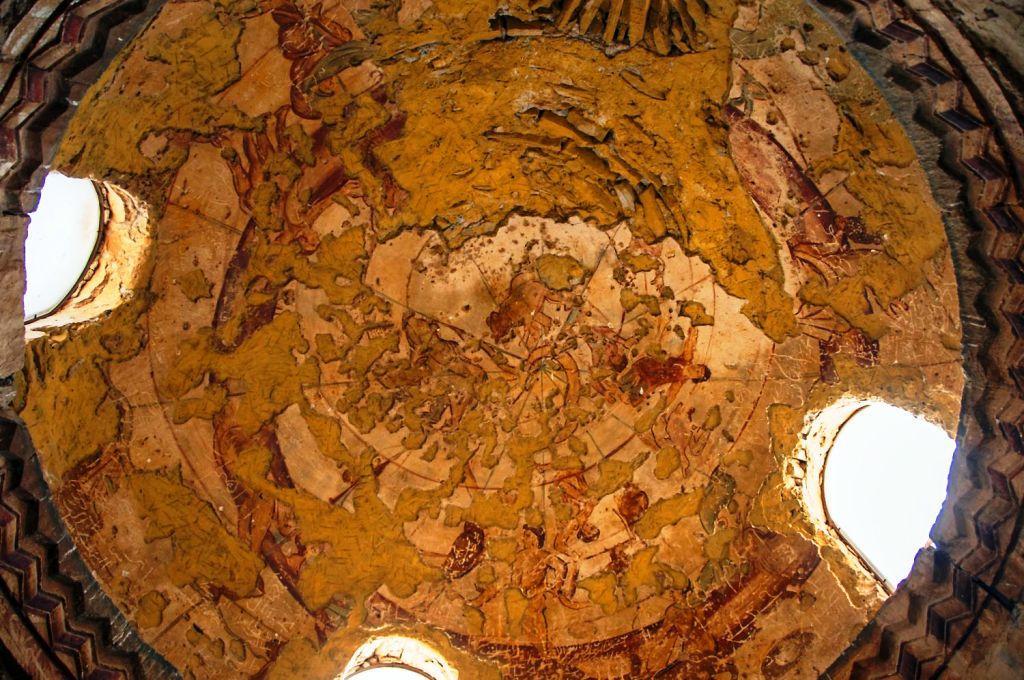
The caldarium or hot bath’s hemispheric dome has a representation of the heavens in which the zodiac is depicted, among separate identifiable constellations.
It is believed to be the earliest image of the night sky painted on anything other than a flat surface. The radii emerge not from the dome’s center but, accurately, from the north celestial pole.
The decoration shown incorrectly in a counterclockwise order indicates the decoration was most likely based upon either a flat drawing or illustration, the source of which is unknown. Showing a remarkable amount of detail, including up to thirty-five identifiable constellations in the hemispheric dome, this early example of depictions of the zodiac provides a reference point from which to base further exploration and examination in the objects to follow.